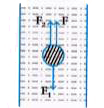State stokes'law .By using it deduce the expression for :
(i) Initial acceleration of smooth sphere and
(ii) Equation of terminal velocity of sphere falling freely through the viscous medium.
(iii) Explain : Upward motion of bubbles produced in fluid.Solution in Gujrati
Scientist Stokes. said that , viscous force FV on small spherical solid body of radius r and moving with velocity v through a viscous medium of large dimensions having coefficient of viscosity η is 6πηrv.

As shown in figure a small spherical body of radius r, density ρ falling in viscous medium of density σ.
Following forces acted on it .
(i) Weight F1=mg=(volume×density)g
=(43πr3ρ))g...(1) (In downward)
Where m = mass of spehre
(ii) Buoyant force F2=mog
=(43πr3σ)g=(2) (in upward)
where m0 = mass of liquid having volume of sphere
(iii) According to stokes.law
Fv=6πηrv ...(3)
Resultant force acting on the sphere,
FR=F1−F2−F(v)
FR=(43πr3ρ)g−(43πr3σ))g−6πηrv
FR=43πr3g(ρ−σ)−6πηrv ...(4)
(i) Equation of initial acceleration
If mass of sphere is m and initial acceleration a0 then
FR=ma0=43π3ρa0
From equation (4),
(43πr3ρ)a0=43πr3g(ρ−σ)−6πηrv
Taking initial velocity of freely falling sphere v=0
(43πr3ρ)a0=43πr3g(ρ−σ)
∴ρ(a0)=g(ρ−σ)
∴a0=(ρ−σ)gρ ...(5)
(ii) Terminal velocity :
As the time passes velocity of sphere will increase hence in equation (3), the force 6πηrv wil increase and resultant force FR decreases.
For any one velocity of spehere FR becomes zero and hence according to Newton first law , spehre moves with constant velocity . This constant velocity is known as final or terminal velocity vt of sphere.
In equation (4) v=vtandFR=0,
∴(6πηr)vt=43πr3g(ρ−σ)
∴vt=29r2g(ρ−σ)η ...(6)
Hence terminal velocity of small sphere in viscous medium vt
(i) Proportional to the square radius of sphere vt∝r2
(ii) Proportional to the difference of densities of sphere and fluid.
vt∝(ρ−σ)
(iii) Inversely proportional to the coefficients of viscosity of fluid vt∝1η.
(iv) Upward motion of bubbles produced in fluid :
The denisty (ρ) of air bubble produced in the fluid is less then the density of fluid (σ) .Hence (ρ<σ), so terminal velocity is negative and hence bubble would travel in upward direction.
Topper's Solved these Questions
- MECHANICAL PROPERTIES OF FLUIDS Book:KUMAR PRAKASHANChapter:MECHANICAL PROPERTIES OF FLUIDS Exercise:SECTION-A Try Yourself (VSQs)
Explore 132 Videos
- MECHANICAL PROPERTIES OF FLUIDS Book:KUMAR PRAKASHANChapter:MECHANICAL PROPERTIES OF FLUIDS Exercise:SECTION - B Numericals
Explore 29 Videos
- MACHANICAL PROPERTIES OF SOLIDS Book:KUMAR PRAKASHANChapter:MACHANICAL PROPERTIES OF SOLIDS Exercise:QUESTION PAPER
Explore 11 Videos
- MOTION IN A STRAIGHT LINE Book:KUMAR PRAKASHANChapter:MOTION IN A STRAIGHT LINE Exercise:QUESTION PAPER
Explore 11 Videos
Similar Questions
What is fluid ?
View SolutionA 14.5 kg mass, fastened to the end of a steel wire of unstretched 1.0 m, is whirled in a vertical circle with an angular velocity of 2 rev/s at the bottom of the circle. The cross- sectional area of the wire is 0.065 cm2. Calculate the elongation of the wire when the mass is at the lowest point of its path.
View SolutionWhat is called brittle material ?
View SolutionDefine frame of reference and give its types.
View SolutionWhen a sphere falling in a viscous fluid attains a terminal velocity, then
View SolutionThe terminal velocity of a sphere moving through a viscous medium is :
View SolutionThe terminal velocity of a sphere of radius R, falling in a viscous fluid, is proportional to
View SolutionDerive an expression for the terminal velocit of a sphere falling through a viscous liquid.
View SolutionA small sphere of volume V falling in a viscous fluid acquires a terminal velocity vt. The terminal velocity of a sphere of volume 8V of the same material and falling in the same fluid will be :
View SolutionShow that terminal velocity of a sphere falling through a viscous medium is proportional to the square of its radius.
View SolutionDerive the expression for the terminal velocity of a sphere moving in a high viscous fluid using stokes force.
View SolutionDerive an expression for the terminal velocit of a sphere falling through a viscous liquid.
View SolutionWrite the formula of initial acceleration of sphere falling in a viscous medium and derive the formula of its terminal velocity from it .
View SolutionAfter terminal velocity is reached the acceleration of a body falling through a viscous fluid is:
View SolutionDerive an expression for terminal velocity of solid falling through viscous fluid.
View Solution